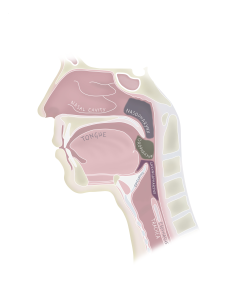50 Pharynx and Larynx
Imagine you’re sitting down for dinner with your best friend. You’re hungry but you have so much to say to your friends. Sometimes you barely have time to catch your breath between bites. Your pharynx is the multitasking structure located just below your nasal and oral cavities which allows air to flow into your lungs and directs food towards your esophagus. The pharynx is a muscular funnel-shaped tube which extends down towards the larynx. Also discussed in Chapter 1, the epiglottis is a large flap of cartilage which covers the larynx and allows passage of food into the esophagus.
As discussed in Chapter 1 the pharynx can be divided into 3 regions from superior to posterior:
- Nasopharynx: uppermost part, behind the nasal cavity
- Oropharynx: middle section, behind the oral cavity
- Laryngopharynx: lowest part, behind the larynx and above the esophagus

Figure 105 The pharynx subsections and larynx
The pharynx might be the first structure that comes to mind when discussing essential functions like breathing and swallowing. The larynx, more commonly known as the voice box, is a cartilaginous chamber connecting the laryngopharynx to the trachea. The larynx is composed of nine cartilages, three unpaired and three paired, connected by ligaments, membranes, and intrinsic skeletal muscles. These muscles adjust the position and tension of the vocal folds by moving the cartilages, allowing us to produce sound and modulate speech.
The largest cartilage of the larynx is the thyroid cartilage, named for its shield-like shape. Positioned anterior to the vocal cords, it acts as a protective barrier, safeguarding the delicate structures involved in sound production.
While present in females, the male’s thyroid cartilage (Adam’s apple) usually develops more during puberty and is more physically visible.

